-
Posts
827 -
Joined
-
Last visited
-
Days Won
4
Content Type
Profiles
Forums
Events
Store
Downloads
Gallery
Posts posted by Lee Bray
-
-
Ford's sekigane tutorial no longer seems to be up.
Unless you're supremely confident of hitting a very small piece of copper with a very small hammer with 100% accuracy many times, I wouldn't try this technique on antique tsuba.
-
Mei doesn't look bad.
Possible nidai?
-
How do you remount a mount?
Blades need mounting; there is no blade.
Unless we're talking about remounting a tsunagi?
-
Thanks, guys.
Owner sends his thanks, too.
-
I'm having trouble translating this mei that was posted on another forum. I have permission to repost the owner's photographs here for a proper translation.
I see ten kanji and read them as - X Tachibana Iga (no) Kami Nyudo Minamoto Mitsuhira.
Could someone kindly please fill in the blank and correct any mistakes?
Cheers.
-
I only saw one blade in gunto mounts in the pics...did anyone notice if WWII gendaito are offered there?
Thanks for posting,
Yes, Gendaito are offered at some stalls.
If memory serves, when I last went three years back, there was a full stall dedicated to WWII katana.
Well worth the trip, George.
-
-
Please pay all bank fees , they say.
Bank transfer is expencive and the transfer could have coursed issues.
Not related to the topic but bank transfer is much cheaper than paypal when you get over a certain price, as the transfer is a set fee rather than paypal's percentage.
I'd also think transfer between banks is much less prone to issues than a paypal transaction between email addresses.
-
Like, all tsuba look really, really lovely with acid enhancement, man.
Or are you talking about using the acid on the tsuba?

-
I have one in black.
Mine is water buffalo horn.
Don't think yours is buffalo but maybe ivory?
The 'spongy' looking centre is natural and I guess is the new growth area where the dead hair cells 'go' on a living horn/tusk, being that the outer wall and towards the tip is generally fairly solid.
Here's a cross section of an antler I have to show what I mean.
Mine is mounted on a small, Sue Koto shobu Bizen wakizashi, like a hamidashi tsuba.
I don't think the buffalo horn ones are so rare but not seen one in your material unless you count the carved bone tourist tanto you see often.
-
Definitely police?
I don't know much about these dirks/tanto but I owned a police issue Meiji period tanto once and it had the attached insignia on the handle, which Hamish's appears to be missing.
It's probably the overcleaned brass and etched hamon but I get a funny feeling on this one.
Some elements seem ok but some don't. Strange one.
Wish I could be of more help, Hamish.
-
I raised the question, and was given good advice! enjoy what you have. I don't have a problem with that, but knowing what I know now should I have;
a. Avoided this buy because of the paper offered with it.
b. Be unhappy with the seller for passing on a suspicious Kanteisho,.
c. Or could he and I insist that this paper is 100% and leave it to others to prove it wrong. (Ethics here)
d. Would a mumei blade at £5,000.00 suffer financially due to paper, or would it be buyer’s resistance on a resale. (Back to a.)
Denis.
I still enjoy my Shigetaka despite its (now)obvious gimei, fake papers and that I paid slightly over 2kUS because it had kicho papers when I was less informed.
The seller was a caucasion in HK who bought the sword when stationed in Tokyo 30 years prior to me buying it from him several years ago. He wasn't a collector, just wanted a memento from his trip - the sword had been left unoiled since his small bottle of oil that the original dealer gave him had ran out. He'd even taken sandpaper to the blade to remove the worst of the rust(minimal) slightly prior to me buying it.
I hold the seller in no way accountable for the 'mistake' that I made.
He was not a collector, didn't claim to be and was obviously not from our meetings, although he was a thoroughly amicable and genuinely nice guy.
He thought he had a genuine package and sold it as such.
Caveat emptor.
With hindsight, I'd have bargained him down more, but certainly not dismissed the blade because of the papers.
With more Nihonto knowledge, I'd have bargained more because it was a 6th gen Shigetaka wakizashi. If I'd known it was gimei, I'd still have bought it but would have tried to be ruthless with the price.
As it is, I count it as a lesson.
Regarding your point C, if you have to ask about ethics, I feel you're already skirting your own personal ethics.
Point D...depends entirely on the blade.
-
Rust is easily fixed by a layman at home. Suriage needs tools and a degree of skill.
If this was an attempt at suriage, it was done by a monkey with a rock...possibly trying to keep Stephen's rats away...

-
I like that cord wrapped saya.
It's made up of half hitches and finished with a Turk's head knot. The maker dressed his knots well as it all looks very uniform and neat.
You get to imagine that was done on a very long, slow boat home...
-
BTW: Lee, if it were me I think I would remove the date and resubmit it.
Both mei and nengo are done in the same hand plus the sword characteristics don't tally with Echizen Shigetaka works, though I've only compared it with the first three generations as the sixth is impossible to find.
I think it's a clear case of gimei.
I would love to find out who made it but if I had the grand or so it would cost to remove all the mei and resubmit, I'd prefer to give it to Grey for some books I'm missing.
-
Hi Ed.
Good topic. It will/would be interesting to see the percentage of resubmitted blades passing hozon at the same attribution as the previous kicho papers.
I get the feeling you won't get a true figure, regardless how many respond.
A few reasons:
- the blade is obviously gimei; removal of mei being reasonably expensive and therefore whole resubmission process becoming more than the blade's worth or the owner can afford.
(my own bias against kicho papers - viewtopic.php?f=1&t=8593&p=75087&hilit=Shigetaka#p75087)
- owners not wanting to spend the money.
- owners not wanting to be told otherwise(took me awhile
 )
)- owners not wanting modern official record that their 'Masamune is not real.
- knowledgeable Japanese saying that kicho papers are called "certification of Gimei/Gibutsu" - viewtopic.php?f=3&t=16989&p=149712&hilit=kicho+fake+papers#p149712
Essentially, if you're in this hobby for cash, kicho papers are great.
If you're in it for knowledge, education and preservation, then it seems that many kicho papers are not reliable. That many are unreliable, unfortunately, throws the good ones under the bus, as well
I'll be interested in how many documented examples are out there.
-
What is really sad is that these papers got separated from the swords they belong to. Someone went trough the whole shinsa process and paid a good amount of money to have a sword papered, yet idiotic heirs separated the sword from the paper and the paper ended up selling for next to nothing on ebay.
Probably a lesson about storing paper(s) together with the respective sword...
They're kicho papers.
The seller/dealer probably found them in the trash after someone threw them out after getting new hozon papers.
Kicho papers are barely worth the paper they're written on and this type of auction just verifies that.
-
Most Gassan works have a nakago that show a very high level of skill and attention to detail.
The mei shows that same attention to detail and is very artistic, like very good calligraphy.
Your sword doesn't show that to me.
You generally shouldn't judge a sword on its mei, but Gassan works are somewhat of an exception to that, at least to my mind anyway.
A good example - http://www.nihonto.ca/gassan-sadayoshi/
-
...but I wasn't talking about flea market grade copies.
Neither was I.
-
This pretty much nails it. If they were to make a perfect replica the cost to make it (working hours of a skilled smith plus materials plus working hours of a skilled polisher and so on) would be way too high.
There are fully mounted and properly(? - at least they display hamon) heat treated katana coming out of the forges in China which retail for way under US$200. That's retail prices in the US, so with shipping from China and profit margins, the Chinese forges are selling them for less than $100.
This copy of a Shingunto - http://www.youtube.com/watch?v=M2zgYN35Id4 - retails for US$350.
It's not perfect, no, but a lot better than the vast majority of obvious fakes we see. Actual cost would be what, $150-$200?
So, I think you're right in that the manufacturing costs would be higher but I don't think by very much.
I think we've just been lucky so far in that the sword market is small and generally well educated and the Chinese haven't taken full advantage of it. With handbags, watches, DVD's, etc, there is so much more money to be made for a lot less hassle.
Hopefully, with increased wealth across China and their promised political reforms, we might see a decrease in all forms of Chinese fakes but then we might also see flying pigs...
-
If they can already make good copies, then why not make good copies?. Why even sell from China?.
I suppose the simple answer is, because they sell as they are, just takes the right person to come along....
Alex.
They used to say there was a sucker born every minute.
With the exponential growth rise in population, it's probably closer to every second, nowadays...
-
If you check the sellers other items, you'll see he's selling a copy of Fuller & Gregory's Military swords.
Maybe that's where the improvements have come from and now they don't need the book...
Considering that some forges in China have been making decent production katana for some years, I'm surprised it has taken this long to see fakes of this 'quality'.
It does seem that there are still plenty of people who will pay out good money for blatantly obvious fakes so maybe they haven't needed to yet.
-
Fred Lohman is for modern production swords, not for Nihonto.
Even in that field he receives complaints.
You can view a modern assembled koshirae(with antique pieces or modern made ones) as a money losing venture or you can view it as supporting the craftsmen who continue the traditions.
My sword mentor has had new koshirae made in Japan from antique pieces and seems more than happy with them.
Nothing wrong at all with collecting kodugu in boxes but it's nice to see them mounted on what they were made for as well.
-
Logic and art...such a compatible mix...



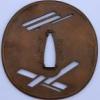


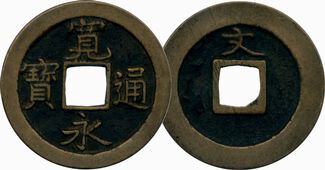
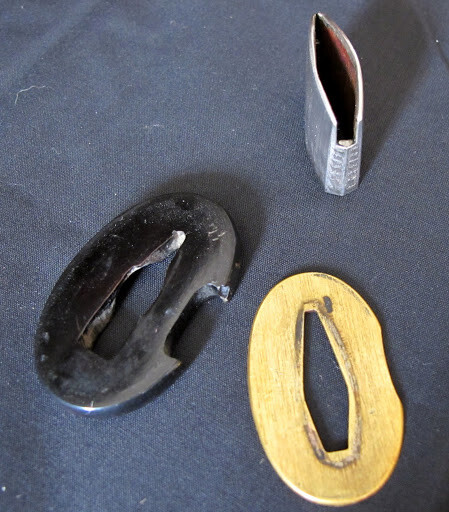
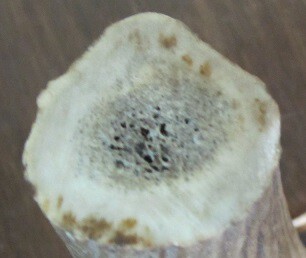
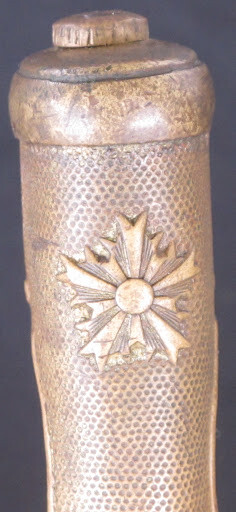
Ford's Sekigana video / photo essay?
in Tosogu
Posted
I thought I might add this as a way of making a 'safer' sekigane.
It relies on a friction fit inside the tsuba ana therefore does not need peening into place so avoiding errant hammer blows on your antique patina.
It's just a piece of copper sheet, though you could use brass, which is the same thickness or slightly thinner than the tsuba.
You'll need a piercing(jeweler's) saw, some small files and some patience to get it right but it's safer than hammering the normal sekigane into place.
Of course, this is the amateur way of doing it.
You really want to send it to the pros to fit proper sekigane.
That way, they know how to fix the patina when they hit it with a hammer...